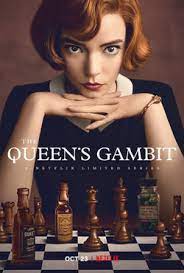Queens Gambit Review
May 19, 2021

Image Courtesy of Wikipedia
From the famously aggressive hustlers loitering around Union Square to the young children immersed in a game at a park, chess has maintained a comfortable position in American culture. This is in part due to the enigmatic American grandmaster Bobby Fischer, who’s ascension to worldwide fame resulted in the game’s popularity. Now, it takes on a new life in The Queen’s Gambit. The show stars Anya Taylor Joy, who plays Beth Harmon, the protagonist heavily inspired by Fischer’s troubled life. The Netflix original is based on the 1983 best seller of the same title by Walter Tevis.
Set during the Cold War, The Queen’s Gambit follows Harmon’s struggles with orphanhood, and addiction, all while being shot into fame due to her world renowned chess skills. Viewers are there for every step of Harmon’s journey to beat the world renowned Russian game master, Vasily Borgov, starting from the death of her mother. Without any other family, she is placed into the orphanage where she begins to play chess, in the basement with the janitor, Mr. Shaibel. Harmon quickly excels, and with the help with the tranquilizer pills that are handed out at the orphanage, she is able to enhance her visualization of the game. Once she is adopted, she joins a competitive chess game, with no prior experience and beats the highest ranking player in the championship, thanks to her skills and the tranquilizers. From there, she joins and wins almost every tournament, travelling all over the United States and Latin America, making friends with some of the players she’s beaten, all while dealing with a growing alcohol and tranquilizer addiction. As Harmon travels up the ranks, she sets her eyes on a bigger competition: the Moscow Invitational, something no American has ever won. Taylor Joy’s incredibly raw performance explores the inescapable grasp of addiction, which she developed at a young age, allows many viewers to sympathize with Harmon. Taylor Joy’s performance brought spectacular critic reviews and sent her home 2 Golden Globe nominations and 1 win for the best Actress In A Miniseries or Motion Picture for TV.
The minutes spent in silence as the players engage in games are captivating, largely in part due to the palpable tension between Beth and her opponents. But the most memorable moments come not when she is at the chessboard but when she is with the people in her life. What makes The Queen’s Gambit so enjoyable even for the viewer unfamiliar with chess (beyond the plot!) is the way in which Beth’s friendships evolve.The support system she has and the friends within it are endlessly obliging and perpetually concerned for Beth’s well being, even when she pushes them away. When she spirals, Jolene comes swooping in to pull her out of her blackhole, and at the dawn of the Moscow Invitational, Benny and Beltik help her practice for the match. The selflessness and care they display for Beth is present in our own lives, when we reflect on the friendships we have. At its core, The Queen’s Gambit is not a convoluted story about a troubled genius but a simple one of a fractured individual’s struggle to accept support. It is a reminder that we do not have to face our burdens alone.
The set designers of The Queen’s Gambit were tasked with a hefty chore – correctly invoking the retro, lavish aesthetic of the 1960s, while making sure it wasn’t too over the top or too unbelievable. The sets display mid century furniture upholstered in blueish-green, white, and brown fabrics. However, not only does the furniture do a spectacular job of displaying the aesthetic, the wallpaper intensifies the exquisite design by decking out the hotels Harmon and her adoptive mom (Alma Weatley) stay in. However, nobody’s house embodies the vision of an American home in the 60s more than Weatley’s; each room is arrayed in colorful patterns ranging from pink plaid in Beth’s room to the bright green bouquets that engulf the dining room. As the show progresses viewers are transformed into the grandiose world of the 60s.
Just like Bobby Fischer’s world wide influence in popularizing chess for the masses, The Queen’s Gambit has brought a new found interest in chess among its audience. Here at Millennium, the chess club has sprung up with vigor and now boasts of twenty five members, a sharp contrast to the handful of members just last year. Charlie Segal, a junior who leads the chess club along with Enver Desic, rebooted the club after a prolonged hiatus due to the pandemic. Said Charlie of the show, “It’s created a much bigger interest in chess, especially with people our age…on chess.com you can even play a Beth Harmon bot.” If you have aspirations to be the next Beth Harmon in our times, or simply want to play a game, you can join the ranks of the grandmaster hopefuls on Thursdays at 3pm virtually.